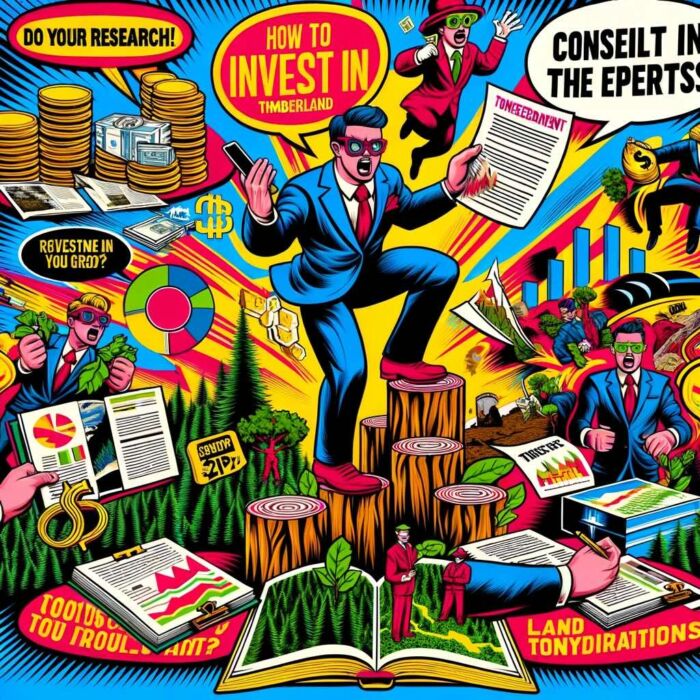Are you tired of the same old traditional investments that everyone else is making? Do you want to add some excitement and diversity to your investment portfolio? Look no further than timberland!
Timberland, as the name suggests, is land primarily used for growing trees for commercial purposes. It may not sound like the sexiest investment option out there, but it has a lot of unique benefits that make it worth considering.
First and foremost, investing in timberland can offer potential for long-term growth and income. Trees take time to grow, so investing in timberland requires patience, but the payoff can be significant. Plus, timberland investments have a low correlation with other asset classes, meaning they can provide a valuable diversification tool for your portfolio.

But that’s not all! Timberland investments can also have potential environmental benefits. By investing in land used for sustainable forestry practices, you’re supporting a renewable resource and contributing to the fight against climate change. And let’s not forget about potential tax benefits, as timberland investments can offer unique tax advantages.
Of course, there are risks and challenges to consider as well. Investing in timberland requires significant upfront costs, and it may take a while before you see any returns. Plus, natural disasters and climate change can pose risks to your investment. And managing timberland isn’t for the faint of heart, as it requires expertise and careful attention to ensure the trees are growing healthily and sustainably.
But if you’re up for the challenge, investing in timberland can be a rewarding and exciting option. In this article, we’ll explore the ins and outs of investing in timberland, from the factors to consider when selecting an investment, to the potential tax implications, to a historical case study on timberland’s performance compared to other asset classes. By the end of this article, you’ll have a better understanding of whether timberland is the right investment option for you. So grab your hard hat and let’s get started!

Benefits Of Investing In Timberland
Investing in timberland can offer a range of benefits to investors seeking to diversify their portfolio. Here are some of the key benefits of investing in timberland:

- Potential for Long-Term Growth and Income: Trees take time to grow, but they can provide a significant source of income once they reach maturity. As the trees grow, they increase in value, and when harvested, can provide a source of revenue for the landowner. Timberland investments have the potential to provide long-term growth and income, making them a valuable addition to any investment portfolio.
- Low Correlation with Other Asset Classes: One of the benefits of investing in timberland is that it has a low correlation with other asset classes. This means that timberland investments may not move in the same direction as other investments in your portfolio, reducing overall portfolio risk. This low correlation can also make timberland investments a valuable diversification tool.
- Potential Environmental Benefits: Investing in timberland can have potential environmental benefits. By investing in land used for sustainable forestry practices, investors are supporting a renewable resource and contributing to the fight against climate change. Additionally, trees absorb carbon dioxide from the atmosphere, making timberland investments a potentially eco-friendly investment option.
- Potential for Tax Benefits: Timberland investments can offer potential tax benefits, making them an attractive option for some investors. In the United States, for example, investors in timberland may be eligible for certain tax deductions and preferential tax treatment. It is important to consult with a tax advisor to determine if these tax benefits apply to your specific situation.
Investing in timberland can offer a range of benefits to investors seeking to diversify their portfolio. From potential long-term growth and income to low correlation with other asset classes and potential environmental and tax benefits, timberland can be a valuable addition to any investment portfolio.
source: Get Rich Education on YouTube

Risks And Challenges Of Investing In Timberland
Investing in timberland can be like planting a seed and watching it grow into a money tree. But just like any investment, it’s not all sunshine and rainbows. There are risks and challenges that investors should be aware of before diving in.
One of the biggest hurdles of investing in timberland is the high upfront costs. You’ll need to have some serious cash on hand to acquire land, plant and manage trees, and wait patiently for years until they mature before you can even think about harvesting them. It’s like waiting for a slow cooker meal, but instead of six hours, you’re waiting for six years, or even longer.
Another challenge of timberland investing is the long-term outlook required. You can’t expect quick returns with timberland investments. You’ll need to be patient and willing to wait until the trees mature and reach their prime harvesting stage. It’s like investing in a savings account, but instead of a few years, you’re waiting for a few decades.
Natural disasters and climate change are also risks associated with timberland investments. Wildfires, floods, and storms can cause significant damage to trees, disrupt harvesting schedules, and hurt profits. Climate change can also affect tree growth and health, requiring investors to be mindful of potential impacts and adapt their management strategies accordingly.
Finally, managing timberland can be a challenging task that requires expertise and careful attention. It’s like being a tree whisperer, but instead of talking to the trees, you’re monitoring them for pests and diseases, managing their growth and harvesting, and ensuring that they are healthy and thriving.
Moreover, investing in timberland is not for the faint of heart. It requires patience, deep pockets, and a willingness to take on risks and challenges. But for those who are up for the challenge, investing in timberland can offer a unique combination of financial and environmental benefits, and can be a rewarding long-term investment strategy.

How To Invest In Timberland
So you’ve decided to take the plunge and invest in timberland, but how exactly do you go about it? There are a few different routes you can take, each with their own pros and cons.
The first option is direct ownership of timberland. This means you purchase the land outright and manage it yourself, or hire a professional management team to handle it for you. This approach gives you full control over the property and allows you to implement your own strategies and management practices. However, it also requires a significant amount of capital upfront, and can be time-consuming and complex to manage.
Another option is investing in timberland funds or Real Estate Investment Trusts (REITs) that specialize in timberland. These funds allow you to invest in a portfolio of timberland properties managed by professionals, without having to manage the properties yourself. This approach can provide a more diversified portfolio, lower entry costs, and potentially higher liquidity. However, it also means you give up some control over the management of the properties, and may be subject to fees and expenses associated with the fund.

When considering a timberland investment, there are several factors to keep in mind. Location is key, as some regions are better suited for timber growth and have stronger markets for wood products. You’ll also want to consider the quality of the timber on the property, as well as the expertise and experience of the management team. The sustainability of the timber harvesting practices is also an important consideration for investors who prioritize environmental responsibility.
Finally, it’s important to be aware of the tax implications of investing in timberland. Depending on how the investment is structured, investors may be able to take advantage of tax benefits such as deductions for management expenses, depletion allowances, and reduced capital gains tax rates. However, it’s important to consult with a tax professional to fully understand the tax implications of a timberland investment.
Consequently, there are several options for investing in timberland, each with its own benefits and challenges. When considering a timberland investment, it’s important to carefully evaluate factors such as location, timber quality, and management expertise, and to be aware of the tax implications of the investment.
source: Whitetail Properties on YouTube

Potential Performance Of Timberland Investments
To understand the potential returns and performance of timberland investments, it’s helpful to compare them to other asset classes. Over the past few decades, timberland investments have generally provided reasonable long-term returns.
However, it’s important to note that timberland returns can vary based on a variety of factors such as location, timber quality, and management practices. In addition, timberland investments require a long-term investment horizon, typically spanning several decades. This means that investors should be prepared to hold the investment for a significant period of time in order to realize its full potential returns.
Looking ahead, the outlook for timberland investments remains positive. With increasing demand for wood products and a growing focus on sustainable forestry practices, the timberland market is poised for continued growth. Additionally, timberland investments may offer potential environmental benefits, as well-managed timberland can sequester carbon and contribute to overall forest health.
Overall, while timberland investments come with their own set of risks and challenges, they have the potential to provide long-term growth and income, diversify a portfolio, and offer potential tax benefits. As with any investment, it’s important to conduct thorough research and due diligence before making a decision.
source: Gokce Capital on YouTube

Timberland Final Thoughts
In conclusion, investing in timberland can offer a range of benefits, including potential long-term growth and income, low correlation with other asset classes, potential environmental benefits, and potential tax advantages. However, it also comes with risks and challenges, such as high upfront costs, a long investment horizon, and risks associated with natural disasters and climate change.
Before making any investment decisions, it’s important to carefully consider these factors and consult with a financial advisor who can provide guidance on whether timberland investments align with your overall investment goals and risk tolerance. Additionally, it’s important to conduct thorough research and due diligence on any potential timberland investment opportunities to ensure they meet your specific investment criteria.
Ultimately, investing in timberland as part of a diversified portfolio can provide an opportunity to add an alternative asset class to your investment mix, potentially increasing returns and reducing overall portfolio risk. However, it’s important to approach this investment with caution and seek professional advice before making any commitments.
source: Mossy Oak on YouTube
Important Information
Comprehensive Investment Disclaimer:
All content provided on this website (including but not limited to portfolio ideas, fund analyses, investment strategies, commentary on market conditions, and discussions regarding leverage) is strictly for educational, informational, and illustrative purposes only. The information does not constitute financial, investment, tax, accounting, or legal advice. Opinions, strategies, and ideas presented herein represent personal perspectives, are based on independent research and publicly available information, and do not necessarily reflect the views or official positions of any third-party organizations, institutions, or affiliates.
Investing in financial markets inherently carries substantial risks, including but not limited to market volatility, economic uncertainties, geopolitical developments, and liquidity risks. You must be fully aware that there is always the potential for partial or total loss of your principal investment. Additionally, the use of leverage or leveraged financial products significantly increases risk exposure by amplifying both potential gains and potential losses, and thus is not appropriate or advisable for all investors. Using leverage may result in losing more than your initial invested capital, incurring margin calls, experiencing substantial interest costs, or suffering severe financial distress.
Past performance indicators, including historical data, backtesting results, and hypothetical scenarios, should never be viewed as guarantees or reliable predictions of future performance. Any examples provided are purely hypothetical and intended only for illustration purposes. Performance benchmarks, such as market indexes mentioned on this site, are theoretical and are not directly investable. While diligent efforts are made to provide accurate and current information, “Picture Perfect Portfolios” does not warrant, represent, or guarantee the accuracy, completeness, or timeliness of any information provided. Errors, inaccuracies, or outdated information may exist.
Users of this website are strongly encouraged to independently verify all information, conduct comprehensive research and due diligence, and engage with qualified financial, investment, tax, or legal professionals before making any investment or financial decisions. The responsibility for making informed investment decisions rests entirely with the individual. “Picture Perfect Portfolios” explicitly disclaims all liability for any direct, indirect, incidental, special, consequential, or other losses or damages incurred, financial or otherwise, arising out of reliance upon, or use of, any content or information presented on this website.
By accessing, reading, and utilizing the content on this website, you expressly acknowledge, understand, accept, and agree to abide by these terms and conditions. Please consult the full and detailed disclaimer available elsewhere on this website for further clarification and additional important disclosures. Read the complete disclaimer here.





